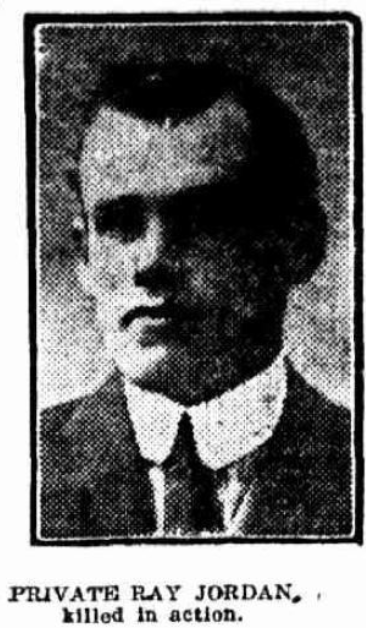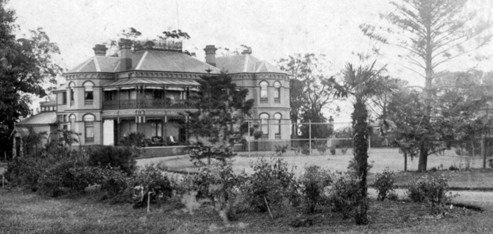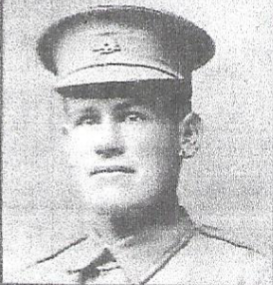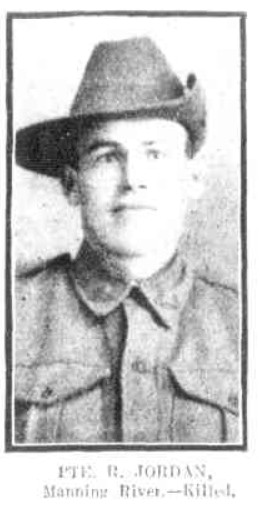
Raymond JORDAN
Eyes hazel, Hair dark brown, Complexion dark
Ray Jordan – One of Six Machine Gunners Lost at Fromelles
We thank members of the Jordan family for their assistance in writing this story.
Can you help find Gunner Ray?
Raymond Jordan was killed in action at Fromelles on 20th July 1916. Like over 1,200 other Australians lost in that single night, his body was never recovered, and he has no known grave.
In 2008, a mass grave was discovered at Pheasant Wood, containing the remains of 250 Australian and British soldiers recovered by the Germans after the battle. Since then, DNA has been used to identify many of the fallen. Family have come forward to help.
Please contact the Fromelles Association of Australia to find out more.
Early Life
Raymond Jordan, known as Ray, was born in 1886 at Taree, New South Wales, the third child of George Thomas Jordan (1851–1928) and Sarah Armstrong (1863–1941). His parents were married in 1881 at Penrith. Ray’s father, George, was the son of a convict transported from Middlesex and an Irish migrant from Tipperary. His mother, Sarah, had an Irish father and an English mother. The Jordan family settled in the Manning River region by 1853 and later established themselves at Bohnock.
Siblings of Ray Jordan:
- George Herbert (1882–1947) – m. Bessie Eva Oxley (1874–1907), then m. Ethel Charlotte Dearnley
- Eliza Beatrice (1883–1954) – m. Edward Greenaway
- Nina Maud (1888–1964) – m. Arthur Collins, then George Weiley
- Vera Emma (1890–1971) – m. George Schmitzer
- Beryl Annie (1893–1965) – m. Percy Drury (AIF), then Eric Jack Standen
- Mabel Kathleen (1896–1968) – m. Percy Schmitzer (AIF)
- Mona Winifred (1898–1974) – m. Thomas Petrie
- Mary Margaret (Maisie) (1902–1993) – m. Bart Friend Dawson
Ray grew up on the lower Manning River, helping with the family’s farming and river transport activities. His early working life included skippering the Myra, a passenger and cargo launch operated by local businessman C.L. Harris. Later, Ray felt a calling to the church and moved to Sydney to study for the Methodist ministry at the Central Methodist Mission Lyceum, Castlereagh Street. The Jordans were a close-knit and community-minded family, known for their service and hospitality. Ray’s Christian convictions, education, and sense of duty would ultimately lead him from the mission field to the battlefields of France.
Methodist Ministry
Ray was a student with a strong sense of purpose and moral clarity. Before the war, he entered the Methodist Mission Lyceum on Castlereagh Street in Sydney, where he studied in preparation for the ministry:
He was a sterling young man— a dutiful son, and a kind and fond brother… He was of fine physique, sound in mind, body, and morals— a young man with a fruitful future before him.
When Ray entered the ministry, his family demonstrated their commitment by entering a £200 bond to support his education—a significant sum at the time. His father, and later his brother George, honoured that bond faithfully by paying £10 per year until the full amount was repaid.
The Methodist Mission Lyceum itself was not only a theological college but also a centre of outreach and social reform. It was part of the Central Methodist Mission, founded in 1885, which had grown rapidly as a force for both evangelism and social good across Sydney and New South Wales.
Ray was one of thirteen students from the Lyceum who had enlisted for war service by 1916. In church records of the time, only one was noted as having already made the ultimate sacrifice:
“Killed in action in France: Corporal Ray Jordan.”
Ray’s life and calling were cut short by the war, but the esteem in which he was held by his peers and church leaders remained undiminished. In letters from the front and in posthumous tributes, he was remembered as “big-hearted,” “much appreciated,” and “promoted to a higher service.”
Off to War
Ray enlisted at Liverpool, New South Wales, on 14 July 1915, aged 29. He initially joined the 9th Reinforcements of the 4th Battalion, a frontline infantry unit. After training in Australia, Ray embarked from Sydney on 20 December 1915 aboard HMAT A29 Suevic, bound for Egypt and the reinforcements then building up for the Western Front.
Upon arrival in Egypt, Ray was transferred to the newly raised 56th Battalion in February 1916, part of the AIF's massive reorganisation after the Gallipoli campaign. The 56th Battalion was formed from veterans of the 4th Battalion and new reinforcements like Ray. However, his path soon changed again. In March 1916, Ray transferred to the 14th Machine Gun Company, one of the new specialist units created to centralise firepower at brigade level.
Machine gun companies required skilled, disciplined soldiers capable of operating heavy Vickers guns under extreme conditions, often under indirect fire. Ray trained with the 14th MGC in Egypt before sailing for France. He departed Alexandria aboard HMT Canada on 19 June 1916, arriving at Marseille on 25 June.
The company endured a gruelling 60-hour train journey across France to reach Thiennes, about 30 kilometres from the front lines near Fromelles. On 10 July, the 14th Machine Gun Company was billeted at Sailly, just behind the front. By 16 July, they had moved into position near Pinney’s Avenue, an exposed zone facing the heavily fortified German stronghold known as the Sugar Loaf Salient. Ray was now in position—only days away from the battle that would take his life.
The Battle of Fromelles

The 14th Machine Gun Company (14th MGC), part of the 14th Infantry Brigade in the 5th Australian Division, played a critical role in the Battle of Fromelles on 19–20 July 1916. Machine gunners were integral to the success of the offensive, expected to provide suppressive fire for the advancing infantry and protect the flanks from German counter-attacks. Equipped with sixteen Vickers medium machine guns, the 14th MGC took up their pre-arranged positions behind the Australian jumping-off trenches.
Their orders were to provide overhead covering fire during the initial assault and switch to direct enfilade fire across the enemy lines once the objective trenches were reached. This required precise coordination, courage under fire, and significant physical effort to manoeuvre the heavy guns and supplies forward under fire.
As C.E.W. Bean recorded in the Official History:
“The machine-guns of the 14th Brigade were posted behind the attacking battalions to provide overhead covering fire and lateral sweeps across the enemy lines. They faced strong counter-battery fire, and their positions were dangerously exposed on open ground.”
The Vickers guns required a crew of three to five men and were extremely heavy, with water-cooled jackets and belts of ammunition that added to the burden. Despite this, they were expected to keep up with the infantry’s progress, adjusting their fire as the battle developed.
At 5.43 PM on 19 July, the infantry assault began. Four waves of Australian soldiers went over the top into no man’s land.
Behind them, the 14th MGC laid down intense supporting fire. Their work was hampered by poor visibility, shattered communication lines, and the mounting casualties around them. The German artillery responded quickly and accurately. The 14th MGC's fixed positions, exposed in open fields or along battered trenches, became immediate targets. Several gun crews were wiped out or severely wounded in place.
Although some infantry units initially reached German trenches, heavy resistance and counter-attacks soon forced many to fall back. The machine gunners had to adjust fire rapidly and in some cases defend their own positions from encroaching enemy forces.
At Fromelles, Ray was operating one of the Vickers guns under intense fire. Eyewitnesses later reported that he was “working his gun” when he was struck and killed. A letter received by Ray’s mother from the mother of a fellow gunner in the same unit gave a clearer picture of what happened:
“Gunner Jordan was wounded in the neck by a bullet at night, and despite the faintness due to the loss of blood, stood to his gun all night. In the early morning, a second bullet hit him in the head, killing him outright.”
The company suffered heavily. Of the 14th MGC’s known strength going into battle, at least six men were killed in action on 19–20 July 1916, including, Private Raymond Jordan (2934), Private Charles Moore (559), Private Francis Walter McKay (2647), Private Henry Francis Briggs (2650), Private Norman Thomas Lee (2767; served as Sydney Harold Atwell) and Private William George May (1352).
After the Battle
Ray was killed in action during the attack at Fromelles on 20 July 1916. Like so many of the fallen, he has no known grave. The first news of his death reached his family at Bohnock in early August. A local paper reported:
On Friday evening Mr. and Mrs. George Jordan, of Bohnock, received the sad news that their second son, Ray, had been killed in action in France… He was a sterling young man— a dutiful son, and a kind and fond brother. He was of fine physique, sound in mind, body, and morals— a young man with a fruitful future before him.
A November 1916 tribute from a Methodist chaplain confirmed Ray’s bravery:
Theological Student Ray Jordan... died fighting at his machine gun.
Ray’s death was especially felt in the Methodist community. He had been training for the ministry at the Central Methodist Mission Lyceum in Sydney, and was described by family and press alike as upright, moral, and kind. Also among those who mourned Ray’s loss were his fellow Methodist ministers and students serving in France. In a letter published months after the battle, Chaplain-Colonel James Green reflected on the deaths of several soldiers, including Ray:
In my last, I spoke of our Methodist divinity student, Jordan, who was killed in action on 19th July. He was a big-hearted fellow, and the young ministers and students out here greatly mourn him… Keast and L. Hall, B.A., were wounded, and Jordan, who was a much appreciated member of their circle, has been promoted to a higher service.
Ray’s memory lived on not only with his family, but among those who knelt with him at communion in muddy French billets and fought beside him at the front. His faith, kindness, and sacrifice were honoured as an enduring example of Christian service in the darkest of places. In 1917, Ray’s sacrifice was remembered across the Methodist Church in Australia. In a formal address to the Conference, the retiring President of the Methodist Church, the Rev. W. Pearson, paid tribute:
One of our students, Raymond Jordan, of Leigh College, has patriotically and loyally given his life for the Empire, and for the cause of freedom, civilisation, and religion. He volunteered for the great war, and fell in France, in defence of a righteous cause.
Ray is commemorated at:
- V.C. Corner Australian Cemetery and Memorial in France
- Strathfield Methodist Church Memorial Tablet
- The Australian War Memorial Roll of Honour.
His legacy continued to be honoured by his siblings, including his elder brother George Herbert Jordan, who was a respected figure in the community for many years and was known for his devotion to family. In 1928, when their father George Thomas Jordan passed away, the family obituary remembered the patriarch as “an old and highly respected resident of Bohnock” and noted that he and Sarah had 25 grandchildren. Ray’s story was never forgotten. The family continued to place memorial notices for years, and his sacrifice was recalled with pride.
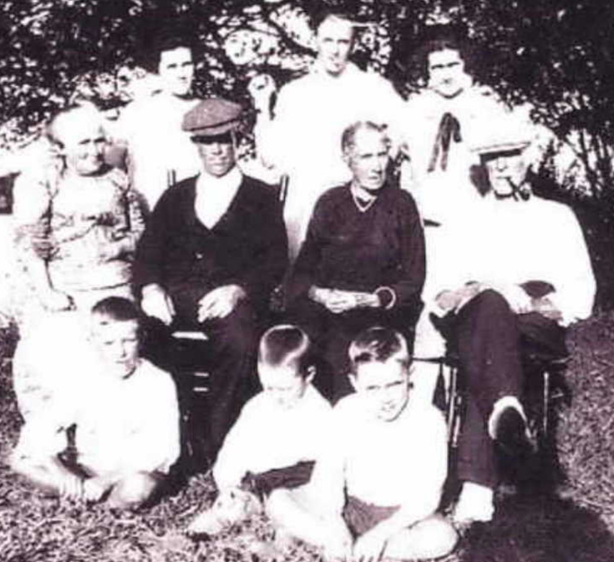
Back Row; Mary Margaret (Maisie) Jordan, Bart Dawson, Mona Winifred Jordan
Middle row: Sarah (nee Armstrong) Jordan far left, George Herbert Jordan, Mary Ann (nee Jordan) Ongley and George Thomas Jordan far right.
Front row: Clinton, William and Jack Jordan (George Herbert’s sons).
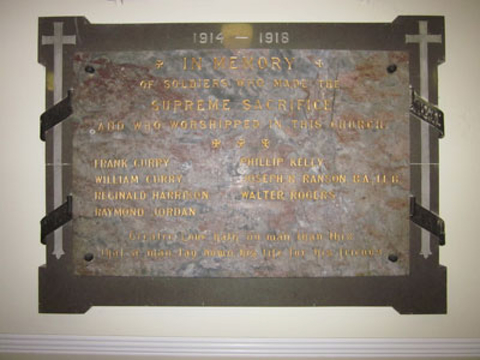
Read as 1914 - 1918. IN MEMORY
Of Soldiers Who Made The SUPREME SACRIFICE, And who worshipped in this Church
Frank Curry Phillip Kelly MMWilliam Curry Joseph Ranson, B.A., LL.B., Reginald Harrison Walter Rogers Ray Jordan
' Greater love hath no man than this, that a man lay down his life for his friends.'
Also on it is Reginald Harrison 2959, from the 56th, who survived Fromelles but kia 30 Sept 1917. Ypres.
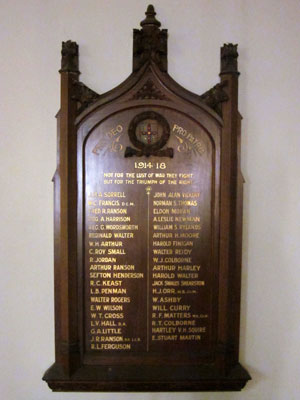
Finding Ray
The search for relatives of Private Raymond Jordan (2934, 14th Machine Gun Company) has borne fruit. Family members have recently come forward, contributing valuable information, family history, and photographs that help preserve Ray’s memory and honour his sacrifice. With their help, we continue the work of remembrance, and — if identification through DNA ever becomes possible — the hope remains that Ray may one day be found and named among the missing.
If you are connected to the Jordan family or have further information, please reach out to the Fromelles Association of Australia.
Family Tree
| Soldier | Raymond Jordan (1886–1916) |
| Parents | George Thomas Jordan (1851–1928), Sarah Armstrong (1863–1941) |
| Siblings | George Herbert (1882–1947), m. Bessie Oxley, then Ethel Dearnley | |||
| Eliza Beatrice (1883–1954), m. Edward Greenaway | ||||
| Nina Maud (1888–1964), m. Arthur Collins then George Weiley | ||||
| Vera Emma (1890–1971), m. George Schmitzer | ||||
| Beryl Annie (1893–1965), m. Percy Drury (AIF) then Eric Jack Standen | ||||
| Mabel Kathleen (1896–1968), m. Percy Schmitzer (AIF) | ||||
| Mona Winifred (1898–1974), m. Thomas Petrie | ||||
| Mary Margaret "Maisie" (1902–1993), m. Bart Friend Dawson |
| Grandparents | |||
| Paternal | George Jordan (1819–1870), Sarah Moran (1821–1856) | ||
| Maternal | James Armstrong (1821–1890), Eliza Eaton (1833–1916) |
The Fromelles Association would love to hear from you

Contacts
(Contact: carla@fromelles.info or geoffrey@fromelles.info).
(Contact: army.uwc@defence.gov.au or phone 1800 019 090).
Donations
If you are able, please contribute to the upkeep of this resource.
(Contact: bill@fromelles.info ).
